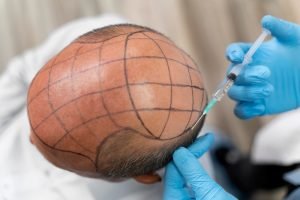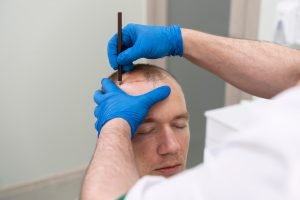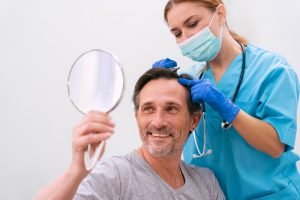Hair, they say, is the crowning glory of one’s appearance. It’s a statement that resonates deeply with anyone who has experienced hair loss. Hair loss isn’t just a physical phenomenon; it can profoundly impact self-esteem and self-image. Understanding the nuances of hair loss, its various types, and its underlying causes is the crucial first step towards effectively addressing this common concern.
The Many Faces of Hair Loss
Hair loss isn’t a one-size-fits-all condition. It comes in various forms, each with its unique characteristics and patterns. Here’s a closer look at the most prevalent types:
Androgenetic Alopecia: The Common Culprit
Androgenetic alopecia, commonly known as male pattern baldness, is perhaps the most recognizable form of hair loss. But it doesn’t discriminate between genders; it affects both men and women. This type of hair loss is gradual and typically starts with hair thinning along the hairline, eventually leading to baldness in specific areas.
For men, it often presents as a receding hairline and a bald spot on the crown, while women may notice overall thinning. Genetics plays a significant role in androgenetic alopecia. If your family has a history of baldness, there’s a higher likelihood that you’ll experience it too.
Alopecia Areata: An Autoimmune Enigma
Alopecia areata takes a more unpredictable and patchy approach to hair loss. This condition is autoimmune in nature, meaning that the body’s immune system mistakenly attacks its hair follicles. The result? Well-defined round patches of hair loss on the scalp or even elsewhere on the body, such as the eyebrows or eyelashes.
The exact cause of alopecia areata remains a mystery, but it’s believed to involve a combination of genetic predisposition and environmental triggers. Stress is often considered a potential trigger, adding to the complexity of this condition.
Alopecia Universalis: The Extreme Case
Alopecia universalis represents the most extreme form of hair loss. In this condition, hair loss goes beyond patches or specific areas; it involves the loss of all body hair, including eyebrows, eyelashes, and even body hair. Alopecia universalis is also an autoimmune disorder, and its exact cause is still under investigation.
Peeling Back the Layers: What Causes Hair Loss?
Understanding hair loss isn’t just about recognizing its types; it’s also about deciphering the underlying causes. Hair loss can be triggered by a multitude of factors, some of which might surprise you:
Genetics: The Family Connection
Genetics, as we’ve already touched upon, is a significant contributor to hair loss, particularly in cases of androgenetic alopecia. If your parents or grandparents experienced hair loss, you may be genetically predisposed to it. While you can’t change your genes, understanding your genetic risk can help you make informed decisions about potential interventions.
Hormonal Changes: The Aging Factor
As we age, our bodies go through various hormonal changes. These fluctuations can have a profound impact on the health of our hair follicles. Hormonal imbalances, often associated with aging, can lead to hair loss. This is why you might notice more hair shedding as you get older. Understanding the role of hormones and discussing hormonal therapies with a healthcare professional can be vital in addressing this type of hair loss.
Medical Conditions: Beyond Skin Deep
Hair loss can also be a symptom of underlying medical conditions. Thyroid disorders, anemia, and autoimmune diseases are just a few examples of health issues that can manifest as hair loss. Addressing the root cause of these conditions, in consultation with a medical professional, is essential to managing hair loss effectively.
Stress: A Hair-Raising Experience
Stress is a common, yet often underestimated, contributor to hair loss. High-stress levels can trigger a condition called telogen effluvium, where hair prematurely enters a resting phase and subsequently falls out. This type of hair loss is usually temporary, but it underscores the importance of stress management in maintaining healthy hair.
Diet and Nutrition: Feeding Your Follicles
The saying “you are what you eat” holds true for your hair as well. Poor nutrition, including deficiencies in essential vitamins and minerals, can lead to hair loss. A balanced diet, rich in nutrients like biotin, iron, and protein, can support healthy hair growth. If you suspect that your diet may be contributing to your hair loss, consider consulting a nutritionist for guidance.
The Path to Solutions
In the world of hair loss, knowledge is power. Understanding the types and causes of hair loss equips you with the insights needed to make informed decisions about potential treatments and interventions. Whether you’re exploring medical therapies, considering lifestyle changes, or simply seeking ways to manage stress, your journey towards healthier, fuller hair begins with understanding the roots of the issue.
**However, it’s essential to note that hair transplantation may not be the recommended solution for cases of Alopecia Areata or Alopecia Universalis.** These conditions, being autoimmune in nature, require specialized treatment approaches that address the underlying immune system dysfunction. Hair transplantation primarily addresses pattern baldness and hair loss caused by factors other than autoimmune disorders.
Remember that hair loss is a common concern, and you’re not alone on this journey. Consulting with a healthcare professional or a specialist in hair restoration can provide you with personalized insights and recommendations tailored to your unique situation. So, whether you’re dealing with androgenetic alopecia, hormonal imbalances, or stress-related hair loss, here are some solutions to consider:
Medical Therapies
For many types of hair loss, medical therapies can be highly effective. These treatments often include medications and topical solutions that promote hair regrowth and slow down further loss. It’s essential to consult with a healthcare professional to determine the most suitable medical therapy for your specific condition.
Lifestyle Changes
In cases where hair loss is influenced by factors like poor nutrition or stress, lifestyle changes can make a significant difference. Maintaining a balanced diet rich in hair-boosting nutrients, managing stress through relaxation techniques or counseling, and adopting a healthy lifestyle can contribute to healthier hair.
Cosmetic Solutions
Cosmetic solutions offer temporary remedies for hair loss. These include hairpieces, wigs, and hair styling techniques that can help conceal thinning areas. While they don’t address the root causes of hair loss, they can provide a quick confidence boost.
Non-Surgical Treatments
Non-surgical treatments, such as platelet-rich plasma (PRP) therapy, have gained popularity for their potential to stimulate hair follicles and promote regrowth. PRP involves drawing a small amount of your blood, processing it to concentrate the platelets, and then injecting the PRP into the scalp.
Hair Transplantation: Not for Everyone
**However, it’s essential to note that hair transplantation may not be the recommended solution for cases of Alopecia Areata or Alopecia Universalis.** These autoimmune conditions require specialized medical management, typically involving immunosuppressive medications and therapies aimed at calming the overactive immune response.
**Hair transplantation relies on the presence of donor hair** – hair follicles that are genetically resistant to the effects of hair loss. In the absence of suitable donor hair, as is often the case with Alopecia Areata and Alopecia Universalis, hair transplantation may not provide the desired results.
Additionally, hair transplantation is a surgical procedure that involves the removal and transplantation of hair follicles from one part of the body to another. It’s a meticulous process that requires a stable donor site, making it less feasible for those with autoimmune-related hair loss.
In Conclusion
Understanding the complexities of hair loss, its types, and its underlying causes empowers you to make informed decisions about the best course of action for your unique situation. Whether you’re exploring medical treatments, making lifestyle changes, or seeking cosmetic solutions, there are options available to help you regain confidence in your appearance.
Remember that seeking guidance from healthcare professionals and specialists in hair restoration is essential. They can provide personalized recommendations and ensure that your chosen treatment aligns with your specific condition and goals. Your journey to healthier, fuller hair starts with knowledge and ends with a renewed sense of self-assurance.
So, embrace your journey, explore your options, and take the first step towards the hair and confidence you deserve.





